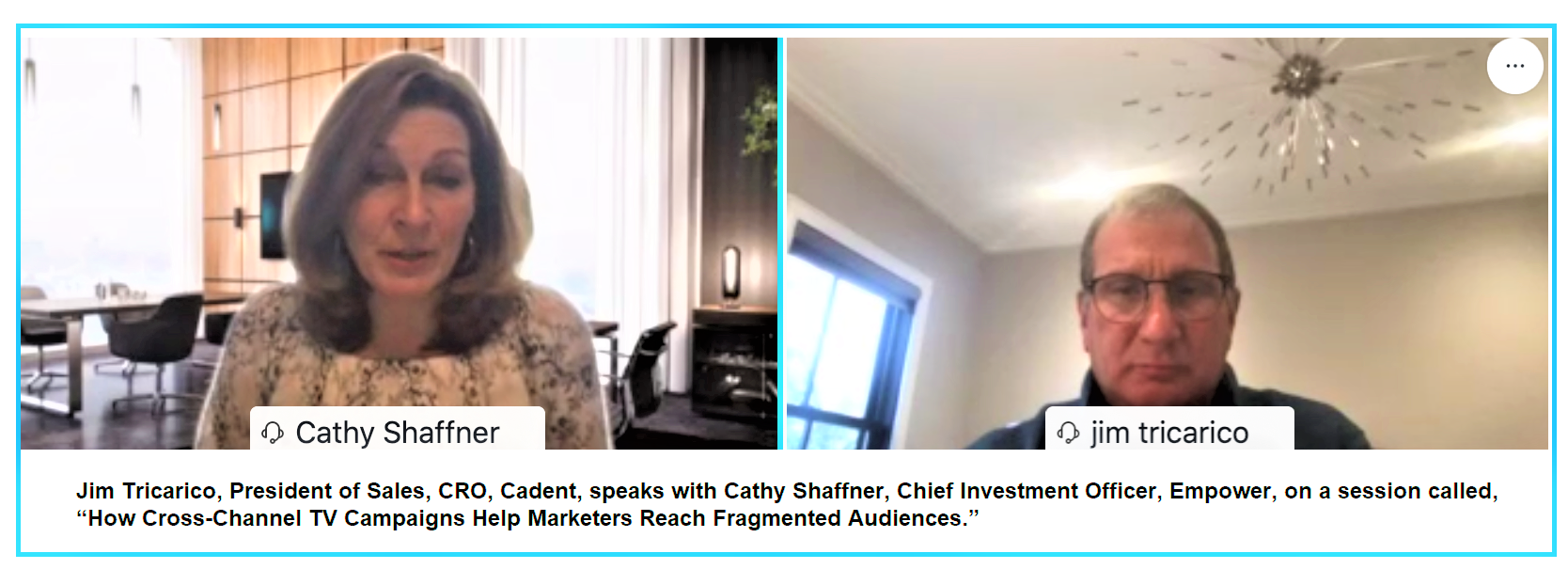Author|Simon Applebaum
Source: www.mediavillage.com, November 2020
The future of TV is unfolding now, and thanks to an extended coronavirus pandemic forcing more people to work from home, unfolding fast. A future where one platform—broadcast, cable, multicast syndication, even the burgeoning assortment of new programmers distributing their content through smart TV sets and connected gadgetry—isn’t enough to satisfy the ambition of national advertisers.
So advocates Jim Tricarico, president of sales and chief revenue officer at Cadent, one of the largest ventures specializing in advanced TV advertising and monetization. At the start of last week’s virtual “Future of TV Summit” sponsored by his company, Tricarico encouraged viewers to adopt an ecosystem approach to future TV advertising relationships, instead of directing the lion’s share of spending for a campaign to one vehicle or another.
“TV is not dead—TV is far from dead,” continued Tricarico. “TV is all grown up, and people are watching on more platforms than ever. It’s all TV, and at some point, it will all come together and it’s all about watching content. It will have a new definition.”
Declines in linear TV network and syndicated program audiences, along with an acceleration of cord-cutting among cable and satellite TV households, will force ad agencies and media buyers to pull together multi-platform strategies that aggregate audiences. Key elements of these strategies: quality of data resources, attribution, addressable capabilities and retail/commerce sales results.
By the end of this decade, “you won’t event recognize this marketplace today,” believes Tricarico. “These changes are coming. All this is a staple of how we move forward over the next two, three or five years.”
The road to getting from one marketplace to the other will require mastery of three functions successfully says Tricarico—flexibility, addressability and measurability. “No more silos,” he declared. “They all need to work together.” In the end, sponsors will deliver specific messages to specific households via specific shows.
“Your opening comments sure hit home,” responded Cathy Shaffner, who joined Tricarico for the summit’s opening fireside chat. Shaffner is chief investment officer of Empower, the ad agency whose clients include Wendy’s, General Nutrition Centers, Ashley HomeStore and PetSmart pet care centers. “It’s all about the content. You can’t buy one or two nights (a week) of broadcast TV anymore. You can’t buy the channel. You have to find the content. The pandemic has flopped this industry on its head,” she said.
In the last few years, Empower has created a client-first, or in Shaffner’s words, “un-holding company” mentality where TV campaigns are designed to target specific platforms and programs. First and third-party data collection and crunching are major assets. A team of in-house scientists and researchers combine their findings with targeted demographic measurement. “That allows you to be agile and be nimble,” Shaffner added. “It’s about casting a wider net to find the audience.”

In the coming year, Empower will determine what the next stage of its “un-holding company” approach looks like, and how to implement it. “From an audience perspective, we’ll have to figure what the new normal is. We’re going to demand change as consumers,” acknowledges Shaffner. “Look at the digital platforms you’re using now on a daily basis. More and more content will be put out there.”
A holistic approach to campaign management will develop among the ad agency and media buying establishment, Shaffner suggests. “We must have common measurement across platforms. This year is the kick in the seat that is needed to get us moving forward to where we should have been probably three years ago and where we’ll be three years from now. We’re going to have to shake out and generate a new normal.”
Some more predictions from Shaffner:
•A big jump in cross-platform campaigns, guided by transparency and brand safety.
•More near-term use of Zoom and other video chat services to pitch advertisers and ad campaigns.
•Increased use of social media and online information searches to track product sales and store traffic among consumers.
•More campaigns deployed with performance-based guarantees.
•Far more ad business going to ad-supported content distributed through smart TV products, as part of overall multi-platform campaigns.
•Local TV stations will increase their reliance on local news and community event coverage to stay in business.
Click the social buttons to share this story with colleagues and friends.
The opinions expressed here are the author’s views and do not necessarily represent the views of MediaVillage.com/MyersBizNet.

